spring中那些让你爱不释手的代码技巧(spring的故事续集)
Posted king哥Java架构
tags:
篇首语:本文由小常识网(cha138.com)小编为大家整理,主要介绍了spring中那些让你爱不释手的代码技巧(spring的故事续集)相关的知识,希望对你有一定的参考价值。
前言
上一篇文章发表之后,受到了不少读者的好评,很多读者都在期待续集。今天非常高兴的通知大家,你们要的续集来了。本文继续总结我认为spring中还不错的知识点,希望对您有所帮助。
一. @Conditional的强大之处
不知道你们有没有遇到过这些问题:
-
某个功能需要根据项目中有没有某个jar判断是否开启该功能。
-
某个bean的实例化需要先判断另一个bean有没有实例化,再判断是否实例化自己。
-
某个功能是否开启,在配置文件中有个参数可以对它进行控制。
如果你有遇到过上述这些问题,那么恭喜你,本节内容非常适合你。
@ConditionalOnClass
问题1可以用@ConditionalOnClass注解解决,代码如下:
public class A {
}
public class B {
}
@ConditionalOnClass(B.class)
@Configuration
public class TestConfiguration {
@Bean
public A a() {
return new A();
}
}
如果项目中存在B类,则会实例化A类。如果不存在B类,则不会实例化A类。
有人可能会问:不是判断有没有某个jar吗?怎么现在判断某个类了?
❝
直接判断有没有该jar下的某个关键类更简单。
❞
这个注解有个升级版的应用场景:比如common工程中写了一个发消息的工具类mqTemplate,业务工程引用了common工程,只需再引入消息中间件,比如rocketmq的jar包,就能开启mqTemplate的功能。而如果有另一个业务工程,通用引用了common工程,如果不需要发消息的功能,不引入rocketmq的jar包即可。
这个注解的功能还是挺实用的吧?
@ConditionalOnBean
问题2可以通过@ConditionalOnBean注解解决,代码如下:
@Configuration
public class TestConfiguration {
@Bean
public B b() {
return new B();
}
@ConditionalOnBean(name="b")
@Bean
public A a() {
return new A();
}
}
实例A只有在实例B存在时,才能实例化。
@ConditionalOnProperty
问题3可以通过@ConditionalOnProperty注解解决,代码如下:
@ConditionalOnProperty(prefix = "demo",name="enable", havingValue = "true",matchIfMissing=true )
@Configuration
public class TestConfiguration {
@Bean
public A a() {
return new A();
}
}
在applicationContext.properties文件中配置参数:
demo.enable=false
各参数含义:
-
prefix 表示参数名的前缀,这里是demo
-
name 表示参数名
-
havingValue 表示指定的值,参数中配置的值需要跟指定的值比较是否相等,相等才满足条件
-
matchIfMissing 表示是否允许缺省配置。
这个功能可以作为开关,相比EnableXXX注解的开关更优雅,因为它可以通过参数配置是否开启,而EnableXXX注解的开关需要在代码中硬编码开启或关闭。
如果你觉得自己学习效率低,缺乏正确的指导,可以加入资源丰富,学习氛围浓厚的技术圈一起学习交流吧!
[Java架构群]
群内有许多来自一线的技术大牛,也有在小厂或外包公司奋斗的码农,我们致力打造一个平等,高质量的JAVA交流圈子,不一定能短期就让每个人的技术突飞猛进,但从长远来说,眼光,格局,长远发展的方向才是最重要的。
其他的Conditional注解
当然,spring用得比较多的Conditional注解还有:ConditionalOnMissingClass、ConditionalOnMissingBean、ConditionalOnWebApplication等。
下面用一张图整体认识一下@Conditional家族。
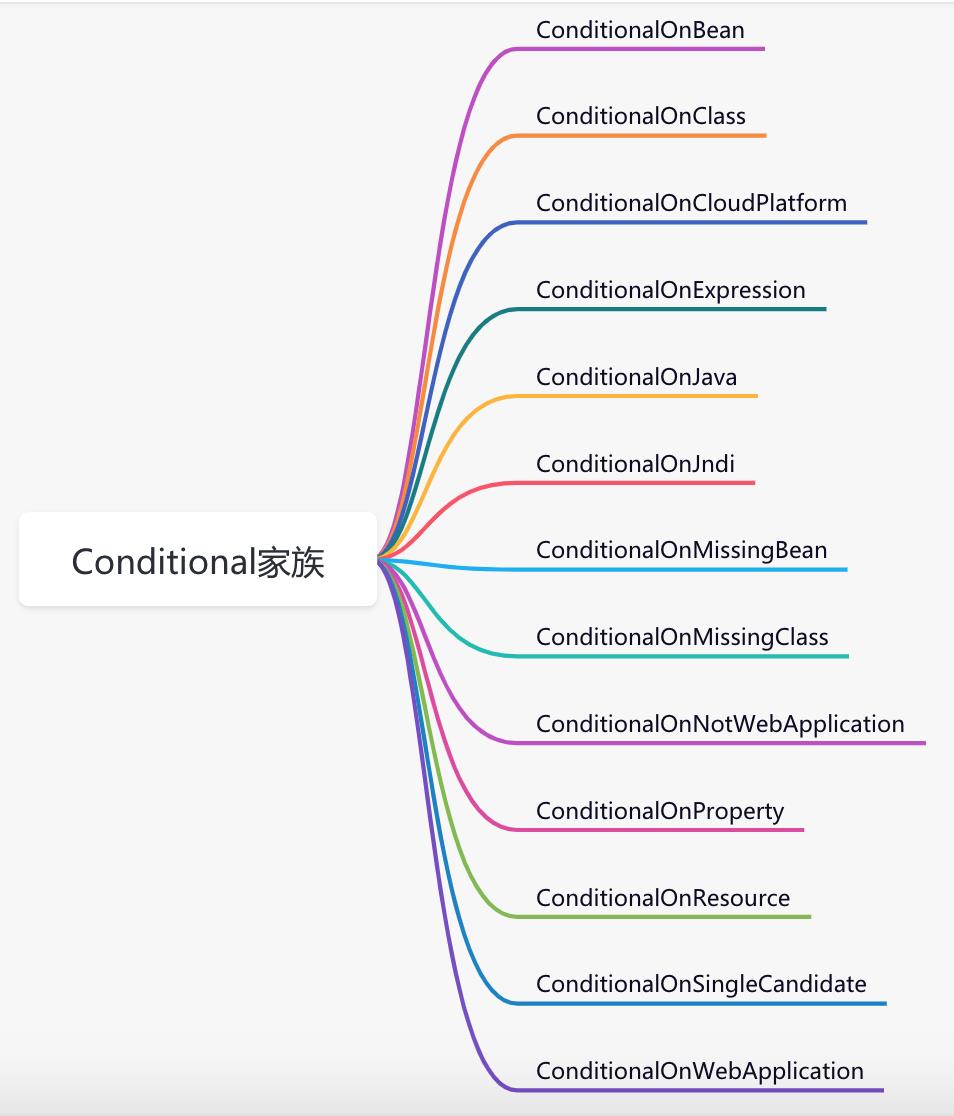
自定义Conditional
说实话,个人认为springboot自带的Conditional系列已经可以满足我们绝大多数的需求了。但如果你有比较特殊的场景,也可以自定义自定义Conditional。
第一步,自定义注解:
@Conditional(MyCondition.class)
@Retention(RetentionPolicy.RUNTIME)
@Target({ElementType.TYPE, ElementType.METHOD})
@Documented
public @interface MyConditionOnProperty {
String name() default "";
String havingValue() default "";
}
第二步,实现Condition接口:
public class MyCondition implements Condition {
@Override
public boolean matches(ConditionContext context, AnnotatedTypeMetadata metadata) {
System.out.println("实现自定义逻辑");
return false;
}
}
第三步,使用@MyConditionOnProperty注解。
Conditional的奥秘就藏在ConfigurationClassParser类的processConfigurationClass方法中:

这个方法逻辑不复杂:
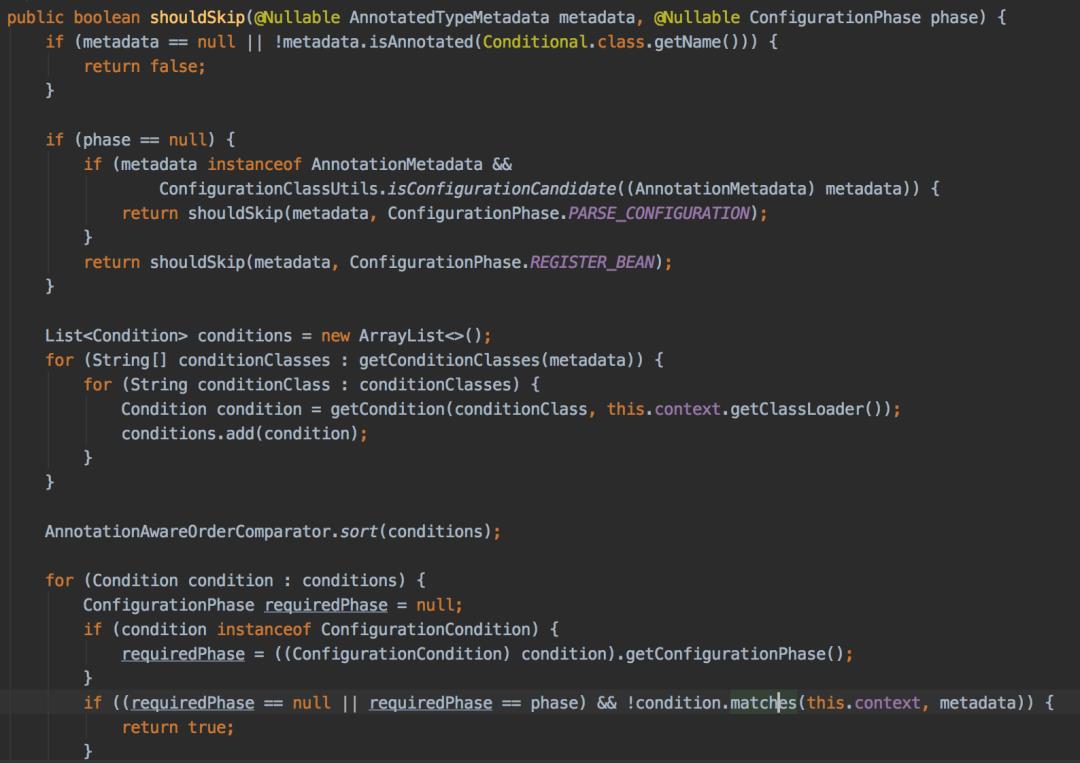
-
先判断有没有使用Conditional注解,如果没有直接返回false
-
收集condition到集合中
-
按
order排序该集合 -
遍历该集合,循环调用
condition的matchs方法。
二. 如何妙用@Import?
有时我们需要在某个配置类中引入另外一些类,被引入的类也加到spring容器中。这时可以使用@Import注解完成这个功能。
如果你看过它的源码会发现,引入的类支持三种不同类型。
但是我认为最好将普通类和@Configuration注解的配置类分开讲解,所以列了四种不同类型:

普通类
这种引入方式是最简单的,被引入的类会被实例化bean对象。
public class A {
}
@Import(A.class)
@Configuration
public class TestConfiguration {
}
通过@Import注解引入A类,spring就能自动实例化A对象,然后在需要使用的地方通过@Autowired注解注入即可:
@Autowired
private A a;
是不是挺让人意外的?不用加@Bean注解也能实例化bean。
@Configuration注解的配置类
这种引入方式是最复杂的,因为@Configuration注解还支持多种组合注解,比如:
-
@Import -
@ImportResource -
@PropertySource等。
public class A {
}
public class B {
}
@Import(B.class)
@Configuration
public class AConfiguration {
@Bean
public A a() {
return new A();
}
}
@Import(AConfiguration.class)
@Configuration
public class TestConfiguration {
}
通过@Import注解引入@Configuration注解的配置类,会把该配置类相关@Import、@ImportResource、@PropertySource等注解引入的类进行递归,一次性全部引入。
由于文章篇幅有限不过多介绍了,这里留点悬念,后面会出一篇文章专门介绍@Configuration注解,因为它实在太太太重要了。
实现ImportSelector接口的类
这种引入方式需要实现ImportSelector接口:
public class AImportSelector implements ImportSelector {
private static final String CLASS_NAME = "com.sue.cache.service.test13.A";
public String[] selectImports(AnnotationMetadata importingClassMetadata) {
return new String[]{CLASS_NAME};
}
}
@Import(AImportSelector.class)
@Configuration
public class TestConfiguration {
}
这种方式的好处是selectImports方法返回的是数组,意味着可以同时引入多个类,还是非常方便的。
实现ImportBeanDefinitionRegistrar接口的类
这种引入方式需要实现ImportBeanDefinitionRegistrar接口:
public class AImportBeanDefinitionRegistrar implements ImportBeanDefinitionRegistrar {
@Override
public void registerBeanDefinitions(AnnotationMetadata importingClassMetadata, BeanDefinitionRegistry registry) {
RootBeanDefinition rootBeanDefinition = new RootBeanDefinition(A.class);
registry.registerBeanDefinition("a", rootBeanDefinition);
}
}
@Import(AImportBeanDefinitionRegistrar.class)
@Configuration
public class TestConfiguration {
}
这种方式是最灵活的,能在registerBeanDefinitions方法中获取到BeanDefinitionRegistry容器注册对象,可以手动控制BeanDefinition的创建和注册。
当然@import注解非常人性化,还支持同时引入多种不同类型的类。
@Import({B.class,AImportBeanDefinitionRegistrar.class})
@Configuration
public class TestConfiguration {
}
这四种引入类的方式各有千秋,总结如下:
-
普通类,用于创建没有特殊要求的bean实例。
-
@Configuration注解的配置类,用于层层嵌套引入的场景。
-
实现ImportSelector接口的类,用于一次性引入多个类的场景,或者可以根据不同的配置决定引入不同类的场景。
-
实现ImportBeanDefinitionRegistrar接口的类,主要用于可以手动控制BeanDefinition的创建和注册的场景,它的方法中可以获取BeanDefinitionRegistry注册容器对象。
在ConfigurationClassParser类的processImports方法中可以看到这三种方式的处理逻辑:

最后的else方法其实包含了:普通类和@Configuration注解的配置类两种不同的处理逻辑。
三. @ConfigurationProperties赋值
我们在项目中使用配置参数是非常常见的场景,比如,我们在配置线程池的时候,需要在applicationContext.propeties文件中定义如下配置:
thread.pool.corePoolSize=5
thread.pool.maxPoolSize=10
thread.pool.queueCapacity=200
thread.pool.keepAliveSeconds=30
方法一:通过@Value注解读取这些配置。
public class ThreadPoolConfig {
@Value("${thread.pool.corePoolSize:5}")
private int corePoolSize;
@Value("${thread.pool.maxPoolSize:10}")
private int maxPoolSize;
@Value("${thread.pool.queueCapacity:200}")
private int queueCapacity;
@Value("${thread.pool.keepAliveSeconds:30}")
private int keepAliveSeconds;
@Value("${thread.pool.threadNamePrefix:ASYNC_}")
private String threadNamePrefix;
@Bean
public Executor threadPoolExecutor() {
ThreadPoolTaskExecutor executor = new ThreadPoolTaskExecutor();
executor.setCorePoolSize(corePoolSize);
executor.setMaxPoolSize(maxPoolSize);
executor.setQueueCapacity(queueCapacity);
executor.setKeepAliveSeconds(keepAliveSeconds);
executor.setThreadNamePrefix(threadNamePrefix);
executor.setRejectedExecutionHandler(new ThreadPoolExecutor.CallerRunsPolicy());
executor.initialize();
return executor;
}
}
这种方式使用起来非常简单,但建议在使用时都加上:,因为:后面跟的是默认值,比如:@Value("${thread.pool.corePoolSize:5}"),定义的默认核心线程数是5。
❝
假如有这样的场景:business工程下定义了这个ThreadPoolConfig类,api工程引用了business工程,同时job工程也引用了business工程,而ThreadPoolConfig类只想在api工程中使用。这时,如果不配置默认值,job工程启动的时候可能会报错。
❞
如果参数少还好,多的话,需要给每一个参数都加上@Value注解,是不是有点麻烦?
此外,还有一个问题,@Value注解定义的参数看起来有点分散,不容易辨别哪些参数是一组的。
这时,@ConfigurationProperties就派上用场了,它是springboot中新加的注解。
第一步,先定义ThreadPoolProperties类
@Data
@Component
@ConfigurationProperties("thread.pool")
public class ThreadPoolProperties {
private int corePoolSize;
private int maxPoolSize;
private int queueCapacity;
private int keepAliveSeconds;
private String threadNamePrefix;
}
第二步,使用ThreadPoolProperties类
@Configuration
public class ThreadPoolConfig {
@Autowired
private ThreadPoolProperties threadPoolProperties;
@Bean
public Executor threadPoolExecutor() {
ThreadPoolTaskExecutor executor = new ThreadPoolTaskExecutor();
executor.setCorePoolSize(threadPoolProperties.getCorePoolSize());
executor.setMaxPoolSize(threadPoolProperties.getMaxPoolSize());
executor.setQueueCapacity(threadPoolProperties.getQueueCapacity());
executor.setKeepAliveSeconds(threadPoolProperties.getKeepAliveSeconds());
executor.setThreadNamePrefix(threadPoolProperties.getThreadNamePrefix());
executor.setRejectedExecutionHandler(new ThreadPoolExecutor.CallerRunsPolicy());
executor.initialize();
return executor;
}
}
使用@ConfigurationProperties注解,可以将thread.pool开头的参数直接赋值到ThreadPoolProperties类的同名参数中,这样省去了像@Value注解那样一个个手动去对应的过程。
这种方式显然要方便很多,我们只需编写xxxProperties类,spring会自动装配参数。此外,不同系列的参数可以定义不同的xxxProperties类,也便于管理,推荐优先使用这种方式。
它的底层是通过:ConfigurationPropertiesBindingPostProcessor类实现的,该类实现了BeanPostProcessor接口,在postProcessBeforeInitialization方法中解析@ConfigurationProperties注解,并且绑定数据到相应的对象上。
绑定是通过Binder类的bindObject方法完成的:
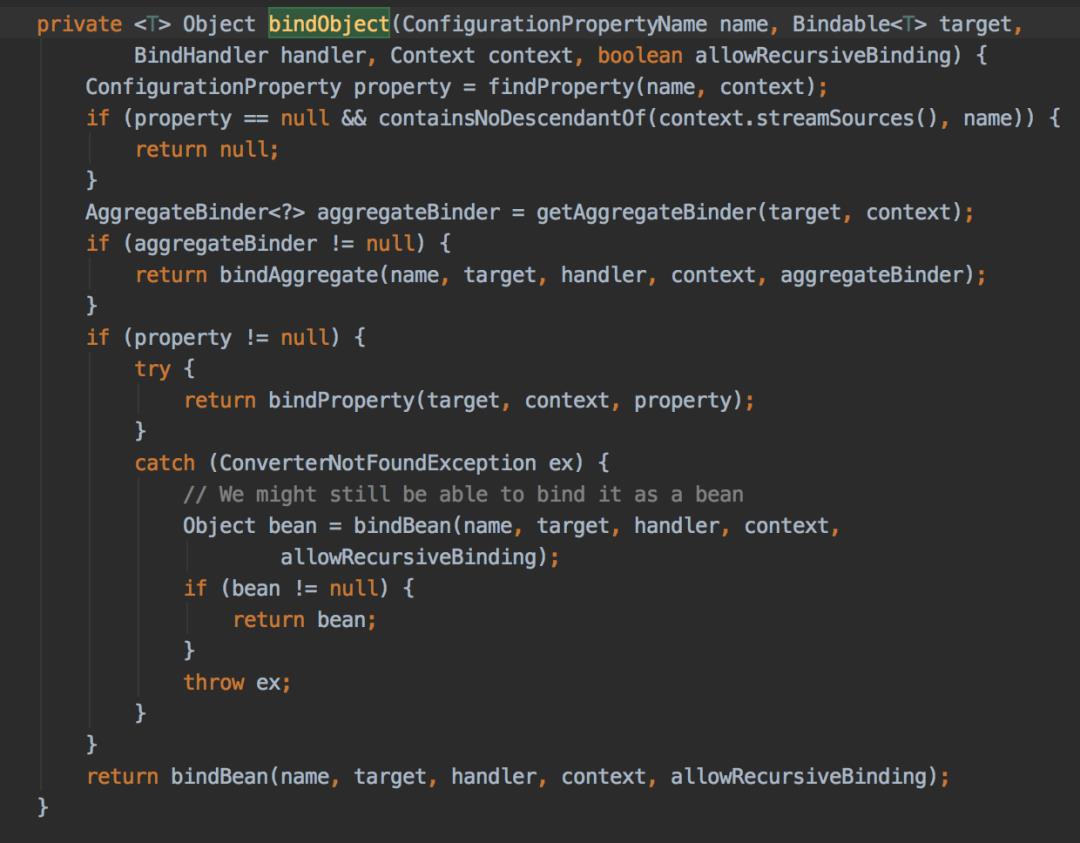
以上这段代码会递归绑定数据,主要考虑了三种情况:
-
bindAggregate绑定集合类 -
bindBean绑定对象 -
bindProperty绑定参数 前面两种情况最终也会调用到bindProperty方法。
「此外,友情提醒一下:」
使用@ConfigurationProperties注解有些场景有问题,比如:在apollo中修改了某个参数,正常情况可以动态更新到@ConfigurationProperties注解定义的xxxProperties类的对象中,但是如果出现比较复杂的对象,比如:
private Map<String, Map<String,String>> urls;
可能动态更新不了。
这时候该怎么办呢?
答案是使用ApolloConfigChangeListener监听器自己处理:
@ConditionalOnClass(com.ctrip.framework.apollo.spring.annotation.EnableApolloConfig.class)
public class ApolloConfigurationAutoRefresh implements ApplicationContextAware {
private ApplicationContext applicationContext;
@Override
public void setApplicationContext(ApplicationContext applicationContext) throws BeansException {
this.applicationContext = applicationContext;
}
@ApolloConfigChangeListener
private void onChange(ConfigChangeEvent changeEvent{
refreshConfig(changeEvent.changedKeys());
}
private void refreshConfig(Set<String> changedKeys){
System.out.println("将变更的参数更新到相应的对象中");
}
}
四. spring事务要如何避坑?
spring中的事务功能主要分为:声明式事务和编程式事务。
声明式事务
大多数情况下,我们在开发过程中使用更多的可能是声明式事务,即使用@Transactional注解定义的事务,因为它用起来更简单,方便。
只需在需要执行的事务方法上,加上@Transactional注解就能自动开启事务:
@Service
public class UserService {
@Autowired
private UserMapper userMapper;
@Transactional
public void add(UserModel userModel) {
userMapper.insertUser(userModel);
}
}
这种声明式事务之所以能生效,是因为它的底层使用了AOP,创建了代理对象,调用TransactionInterceptor拦截器实现事务的功能。
❝
spring事务有个特别的地方:它获取的数据库连接放在
ThreadLocal中的,也就是说同一个线程中从始至终都能获取同一个数据库连接,可以保证同一个线程中多次数据库操作在同一个事务中执行。❞
正常情况下是没有问题的,但是如果使用不当,事务会失效,主要原因如下:
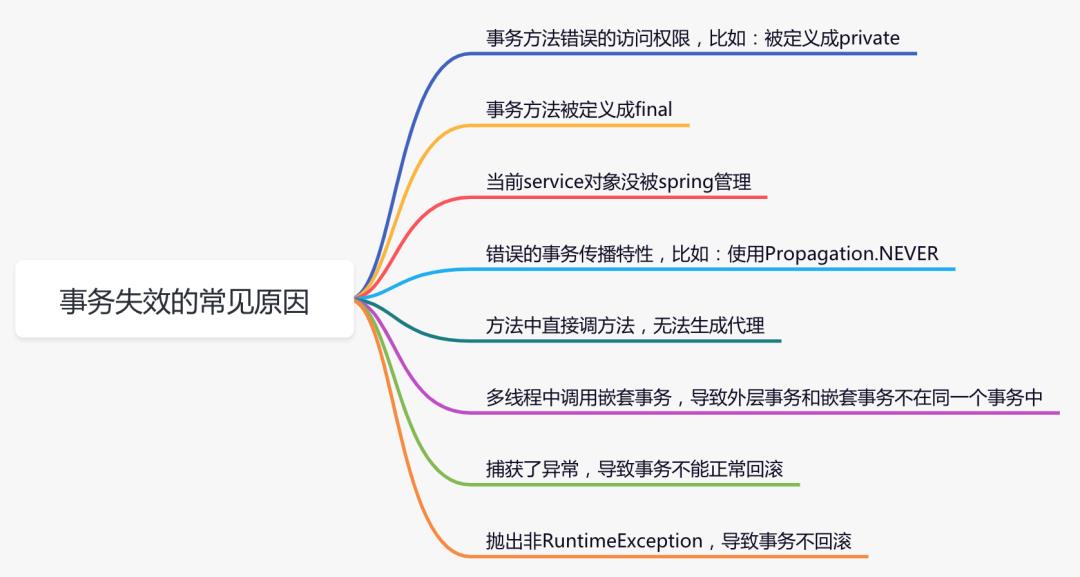
除了上述列举的问题之外,由于@Transactional注解最小粒度是要被定义在方法上,如果有多层的事务方法调用,可能会造成大事务问题。

所以,建议在实际工作中少用@Transactional注解开启事务。
编程式事务
一般情况下编程式事务我们可以通过TransactionTemplate类开启事务功能。有个好消息,就是springboot已经默认实例化好这个对象了,我们能直接在项目中使用。
@Service
public class UserService {
@Autowired
private TransactionTemplate transactionTemplate;
...
public void save(final User user) {
transactionTemplate.execute((status) => {
doSameThing...
return Boolean.TRUE;
})
}
}
使用TransactionTemplate的编程式事务能避免很多事务失效的问题,但是对大事务问题,不一定能够解决,只是说相对于使用@Transactional注解要好些。
五. 跨域问题的解决方案
关于跨域问题,前后端的解决方案还是挺多的,这里我重点说说spring的解决方案,目前有三种:
 一.使用@CrossOrigin注解
一.使用@CrossOrigin注解
@RequestMapping("/user")
@RestController
public class UserController {
@CrossOrigin(origins = "http://localhost:8016")
@RequestMapping("/getUser")
public String getUser(@RequestParam("name") String name) {
System.out.println("name:" + name);
return "success";
}
}
该方案需要在跨域访问的接口上加@CrossOrigin注解,访问规则可以通过注解中的参数控制,控制粒度更细。如果需要跨域访问的接口数量较少,可以使用该方案。
二.增加全局配置
@Configuration
public class WebConfig implements WebMvcConfigurer {
@Override
public void addCorsMappings(CorsRegistry registry) {
registry.addMapping("/**")
.allowedOrigins("*")
.allowedMethods("GET", "POST")
.allowCredentials(true)
.maxAge(3600)
.allowedHeaders("*");
}
}
该方案需要实现WebMvcConfigurer接口,重写addCorsMappings方法,在该方法中定义跨域访问的规则。这是一个全局的配置,可以应用于所有接口。
三.自定义过滤器
@WebFilter("corsFilter")
@Configuration
public class CorsFilter implements Filter {
@Override
public void init(FilterConfig filterConfig) throws ServletException {
}
@Override
public void doFilter(ServletRequest request, ServletResponse response, FilterChain chain) throws IOException, ServletException {
HttpServletResponse httpServletResponse = (HttpServletResponse) response;
httpServletResponse.setHeader("Access-Control-Allow-Origin", "*");
httpServletResponse.setHeader("Access-Control-Allow-Methods", "POST, GET");
httpServletResponse.setHeader("Access-Control-Max-Age", "3600");
httpServletResponse.setHeader("Access-Control-Allow-Headers", "x-requested-with");
chain.doFilter(request, response);
}
@Override
public void destroy() {
}
}
该方案通过在请求的header中增加Access-Control-Allow-Origin等参数解决跨域问题。
顺便说一下,使用@CrossOrigin注解 和 实现WebMvcConfigurer接口的方案,spring在底层最终都会调用到DefaultCorsProcessor类的handleInternal方法:
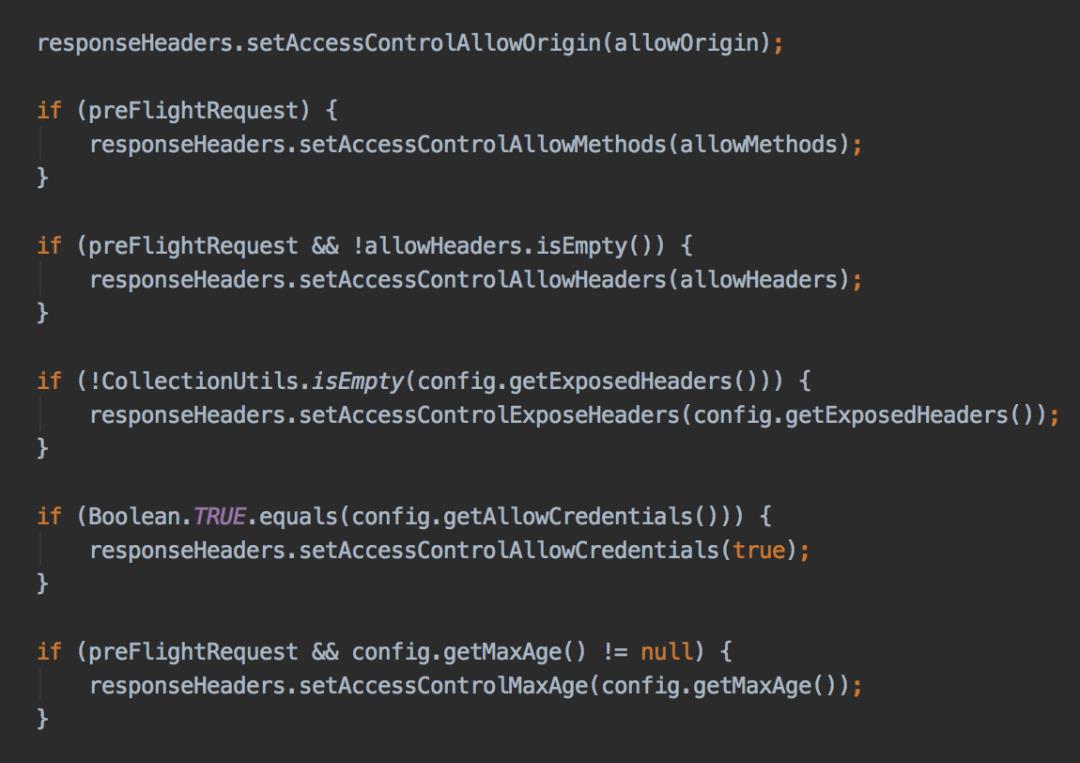
最终三种方案殊途同归,都会往header中添加跨域需要参数,只是实现形式不一样而已。
六. 如何自定义starter
以前在没有使用starter时,我们在项目中需要引入新功能,步骤一般是这样的:
-
在maven仓库找该功能所需jar包
-
在maven仓库找该jar所依赖的其他jar包
-
配置新功能所需参数
以上这种方式会带来三个问题:
-
如果依赖包较多,找起来很麻烦,容易找错,而且要花很多时间。
-
各依赖包之间可能会存在版本兼容性问题,项目引入这些jar包后,可能没法正常启动。
-
如果有些参数没有配好,启动服务也会报错,没有默认配置。
「为了解决这些问题,springboot的starter机制应运而生」。
starter机制带来这些好处:
-
它能启动相应的默认配置。
-
它能够管理所需依赖,摆脱了需要到处找依赖 和 兼容性问题的困扰。
-
自动发现机制,将spring.factories文件中配置的类,自动注入到spring容器中。
-
遵循“约定大于配置”的理念。
在业务工程中只需引入starter包,就能使用它的功能,太爽了。
下面用一张图,总结starter的几个要素:
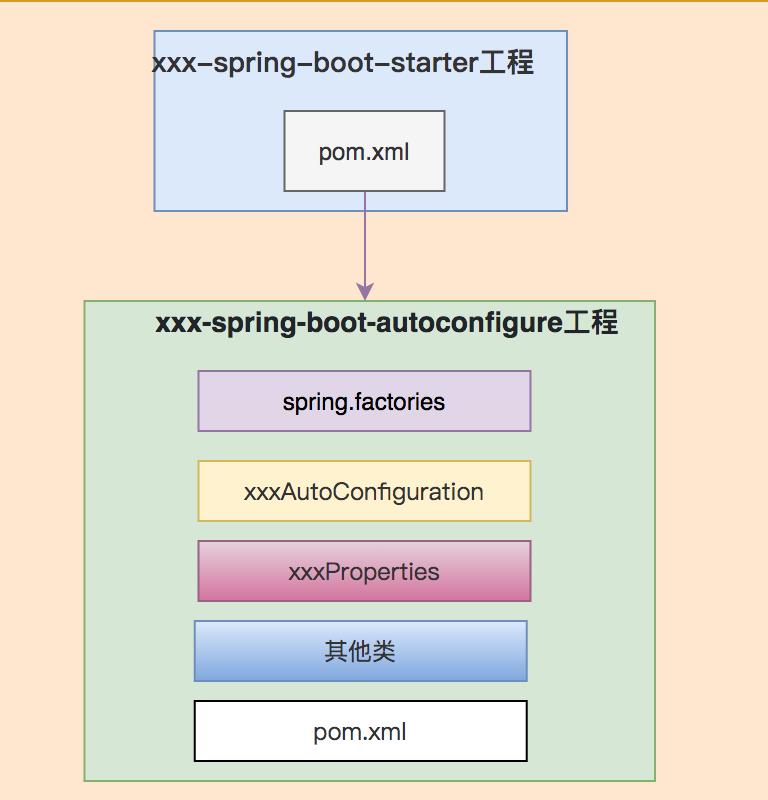
接下来我们一起实战,定义一个自己的starter。
第一步,创建id-generate-starter工程: 其中的pom.xml配置如下:
其中的pom.xml配置如下:
<?xml version="1.0" encoding="UTF-8"?>
<project xmlns="http://maven.apache.org/POM/4.0.0" xmlns:xsi="http://www.w3.org/2001/XMLSchema-instance" xsi:schemaLocation="http://maven.apache.org/POM/4.0.0 http://maven.apache.org/xsd/maven-4.0.0.xsd">
<modelVersion>4.0.0</modelVersion>
<version>1.3.1</version>
<groupId>com.sue</groupId>
<artifactId>id-generate-spring-boot-starter</artifactId>
<name>id-generate-spring-boot-starter</name>
<dependencies>
<dependency>
<groupId>com.sue</groupId>
<artifactId>id-generate-spring-boot-autoconfigure</artifactId>
<version>1.3.1</version>
</dependency>
</dependencies>
</project>
第二步,创建id-generate-spring-boot-autoconfigure工程: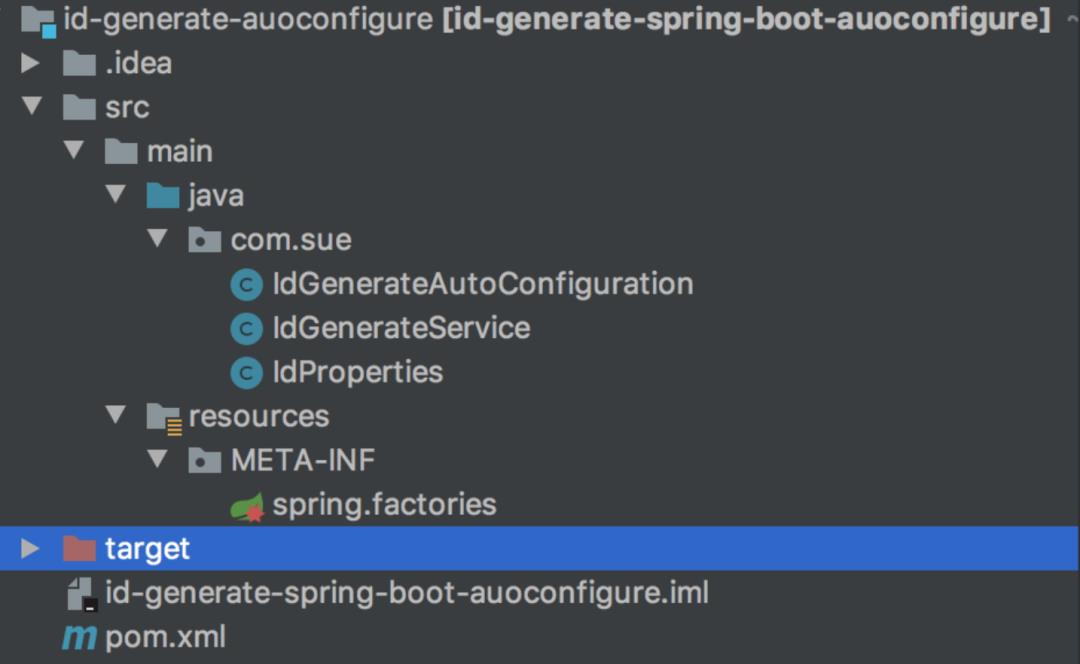 该项目当中包含:
该项目当中包含:
-
pom.xml
-
spring.factories
-
IdGenerateAutoConfiguration
-
IdGenerateService
-
IdProperties pom.xml配置如下:
<?xml version="1.0" encoding="UTF-8"?>
<project xmlns="http://maven.apache.org/POM/4.0.0" xmlns:xsi="http://www.w3.org/2001/XMLSchema-instance" xsi:schemaLocation="http://maven.apache.org/POM/4.0.0 http://maven.apache.org/xsd/maven-4.0.0.xsd">
<parent>
<groupId>org.springframework.boot</groupId>
<artifactId>spring-boot-starter-parent</artifactId>
<version>2.0.4.RELEASE</version>
</parent>
<modelVersion>4.0.0</modelVersion>
<version>1.3.1</version>
<groupId>com.sue</groupId>
<artifactId>id-generate-spring-boot-autoconfigure</artifactId>
<name>id-generate-spring-boot-autoconfigure</name>
<dependencies>
<dependency>
<groupId>org.springframework.boot</groupId>
<artifactId>spring-boot-starter</artifactId>
</dependency>
<dependency>
<groupId>org.springframework.boot</groupId>
<artifactId>spring-boot-autoconfigure</artifactId>
</dependency>
<dependency>
<groupId>org.springframework.boot</groupId>
<artifactId>spring-boot-configuration-processor</artifactId>
<optional>true</optional>
</dependency>
</dependencies>
<build>
<plugins>
<plugin>
<groupId>org.apache.maven.plugins</groupId>
<artifactId>maven-compiler-plugin</artifactId>
<configuration>
<source>1.8</source>
<target>1.8</target>
</configuration>
</plugin>
</plugins>
</build>
</project>
spring.factories配置如下:
org.springframework.boot.autoconfigure.EnableAutoConfiguration=com.sue.IdGenerateAutoConfiguration
IdGenerateAutoConfiguration类:
@ConditionalOnClass(IdProperties.class)
@EnableConfigurationProperties(IdProperties.class)
@Configuration
public class IdGenerateAutoConfiguration {
@Autowired
private IdProperties properties;
@Bean
public IdGenerateService idGenerateService() {
return new IdGenerateService(properties.getWorkId());
}
}
IdGenerateService类:
public class IdGenerateService {
private Long workId;
public IdGenerateService(Long workId) {
this.workId = workId;
}
public Long generate() {
return new Random().nextInt(100) + this.workId;
}
}
IdProperties类:
@ConfigurationProperties(prefix = IdProperties.PREFIX)
public class IdProperties {
public static final String PREFIX = "sue";
private Long workId;
public Long getWorkId() {
return workId;
}
public void setWorkId(Long workId) {
this.workId = workId;
}
}
这样在业务项目中引入相关依赖:
<dependency>
<groupId>com.sue</groupId>
<artifactId>id-generate-spring-boot-starter</artifactId>
<version>1.3.1</version>
</dependency>
就能使用注入使用IdGenerateService的功能了
@Autowired
private IdGenerateService idGenerateService;
完美。
七.项目启动时的附加功能
有时候我们需要在项目启动时定制化一些附加功能,比如:加载一些系统参数、完成初始化、预热本地缓存等,该怎么办呢?
好消息是springboot提供了:
-
CommandLineRunner
-
ApplicationRunner
这两个接口帮助我们实现以上需求。
它们的用法还是挺简单的,以ApplicationRunner接口为例:
@Component
public class TestRunner implements ApplicationRunner {
@Autowired
private LoadDataService loadDataService;
public void run(ApplicationArguments args) throws Exception {
loadDataService.load();
}
}
实现ApplicationRunner接口,重写run方法,在该方法中实现自己定制化需求。
如果项目中有多个类实现了ApplicationRunner接口,他们的执行顺序要怎么指定呢?
答案是使用@Order(n)注解,n的值越小越先执行。当然也可以通过@Priority注解指定顺序。
springboot项目启动时主要流程是这样的:

在SpringApplication类的callRunners方法中,我们能看到这两个接口的具体调用:
最后还有一个问题:这两个接口有什么区别?
-
CommandLineRunner接口中run方法的参数为String数组
-
ApplicationRunner中run方法的参数为ApplicationArguments,该参数包含了String数组参数 和 一些可选参数。
一直想整理出一份完美的面试宝典,但是时间上一直腾不开,这套一千多道面试题宝典,结合今年金三银四各种大厂面试题,以及 GitHub 上 star 数超 30K+ 的文档整理出来的,我上传以后,毫无意外的短短半个小时点赞量就达到了 13k,说实话还是有点不可思议的。
一千道互联网 Java 工程师面试题
内容涵盖:Java、MyBatis、ZooKeeper、Dubbo、Elasticsearch、Memcached、Redis、mysql、Spring、SpringBoot、SpringCloud、RabbitMQ、Kafka、Linux等技术栈(485页)

初级—中级—高级三个级别的大厂面试真题
阿里云——Java 实习生/初级
List 和 Set 的区别 HashSet 是如何保证不重复的
HashMap 是线程安全的吗,为什么不是线程安全的(最好画图说明多线程环境下不安全)?
HashMap 的扩容过程
HashMap 1.7 与 1.8 的 区别,说明 1.8 做了哪些优化,如何优化的?
对象的四种引用
Java 获取反射的三种方法
Java 反射机制
Arrays.sort 和 Collections.sort 实现原理 和区别
Cloneable 接口实现原理
异常分类以及处理机制
wait 和 sleep 的区别
数组在内存中如何分配
答案展示:

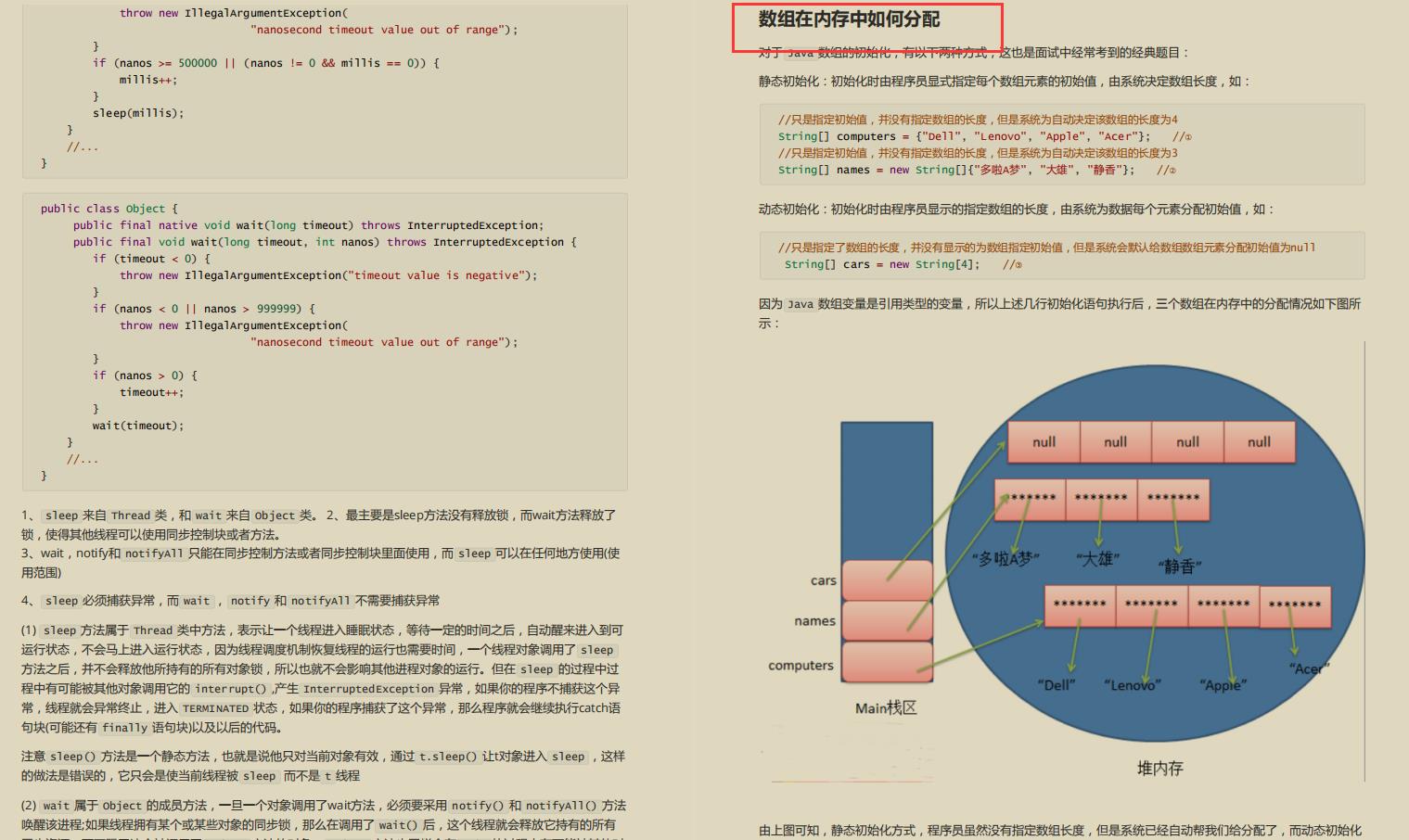
美团——Java 中级
BeanFactory 和 ApplicationContext 有什么区别
Spring Bean 的生命周期
Spring IOC 如何实现
说说 Spring AOP
Spring AOP 实现原理
动态代理(cglib 与 JDK)
Spring 事务实现方式
Spring 事务底层原理
如何自定义注解实现功能
Spring MVC 运行流程
Spring MVC 启动流程
Spring 的单例实现原理
Spring 框架中用到了哪些设计模式
为什么选择 Netty
说说业务中,Netty 的使用场景
原生的 NIO 在 JDK 1.7 版本存在 epoll bug
什么是 TCP 粘包/拆包
TCP 粘包/拆包的解决办法
Netty 线程模型
说说 Netty 的零拷贝
Netty 内部执行流程
答案展示:


蚂蚁金服——Java 高级
题 1:
jdk1.7 到 jdk1.8 Map 发生了什么变化(底层)?
ConcurrentHashMap
并行跟并发有什么区别?
jdk1.7 到 jdk1.8 java 虚拟机发生了什么变化?
如果叫你自己设计一个中间件,你会如何设计?
什么是中间件?
ThreadLock 用过没有,说说它的作用?
Hashcode()和 equals()和==区别?
mysql 数据库中,什么情况下设置了索引但无法使用?
mysql 优化会不会,mycat 分库,垂直分库,水平分库?
分布式事务解决方案?
sql 语句优化会不会,说出你知道的?
mysql 的存储引擎了解过没有?
红黑树原理?
题 2:
说说三种分布式锁?
redis 的实现原理?
redis 数据结构,使⽤场景?
redis 集群有哪⼏种?
codis 原理?
是否熟悉⾦融业务?记账业务?蚂蚁⾦服对这部分有要求。
好啦~展示完毕,大概估摸一下自己是青铜还是王者呢?
前段时间,在和群友聊天时,把今年他们见到的一些不同类别的面试题整理了一番,于是有了以下面试题集,也一起分享给大家~
如果你觉得这些内容对你有帮助,可以加入csdn进阶交流群,领取资料
基础篇

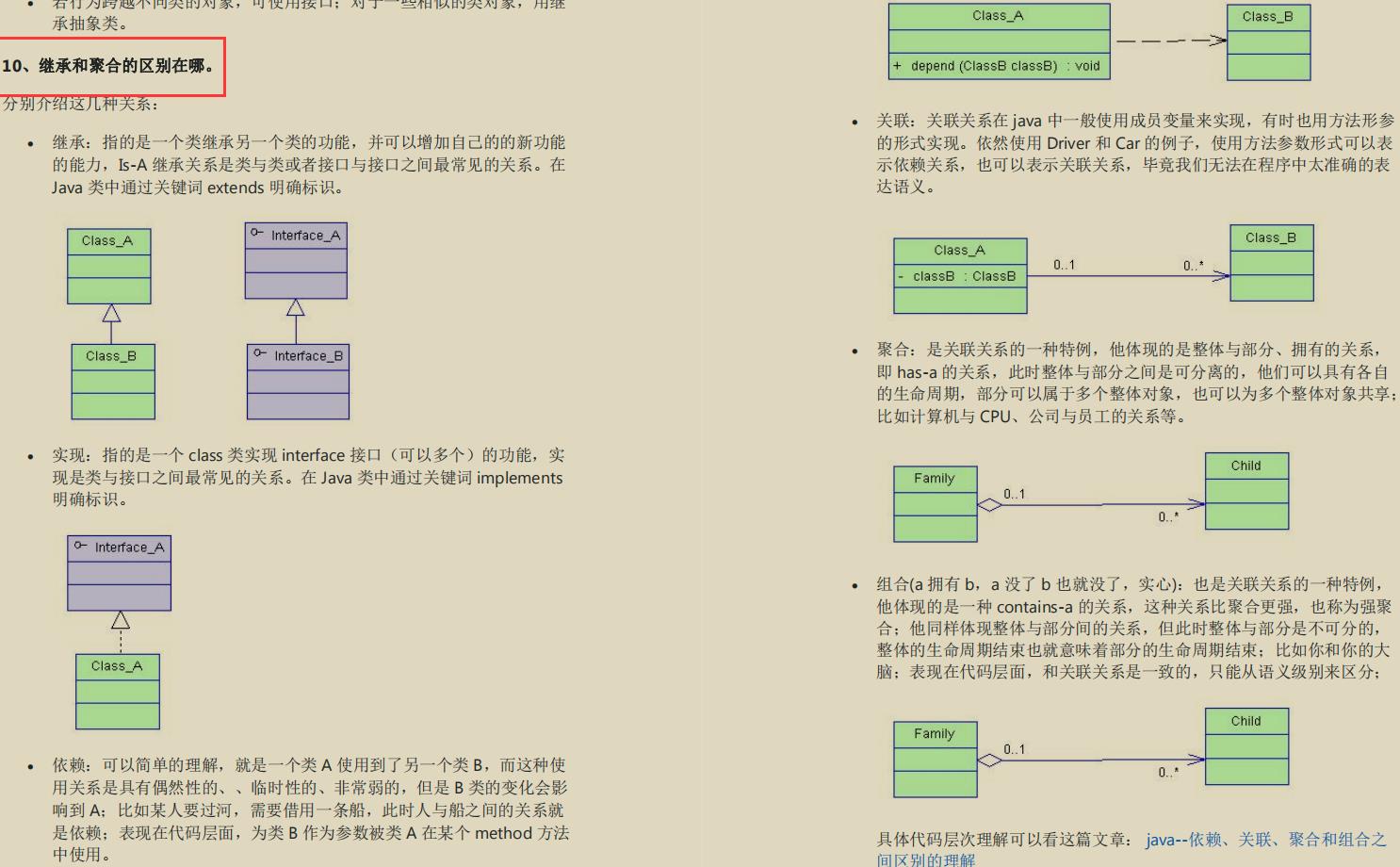
JVM 篇
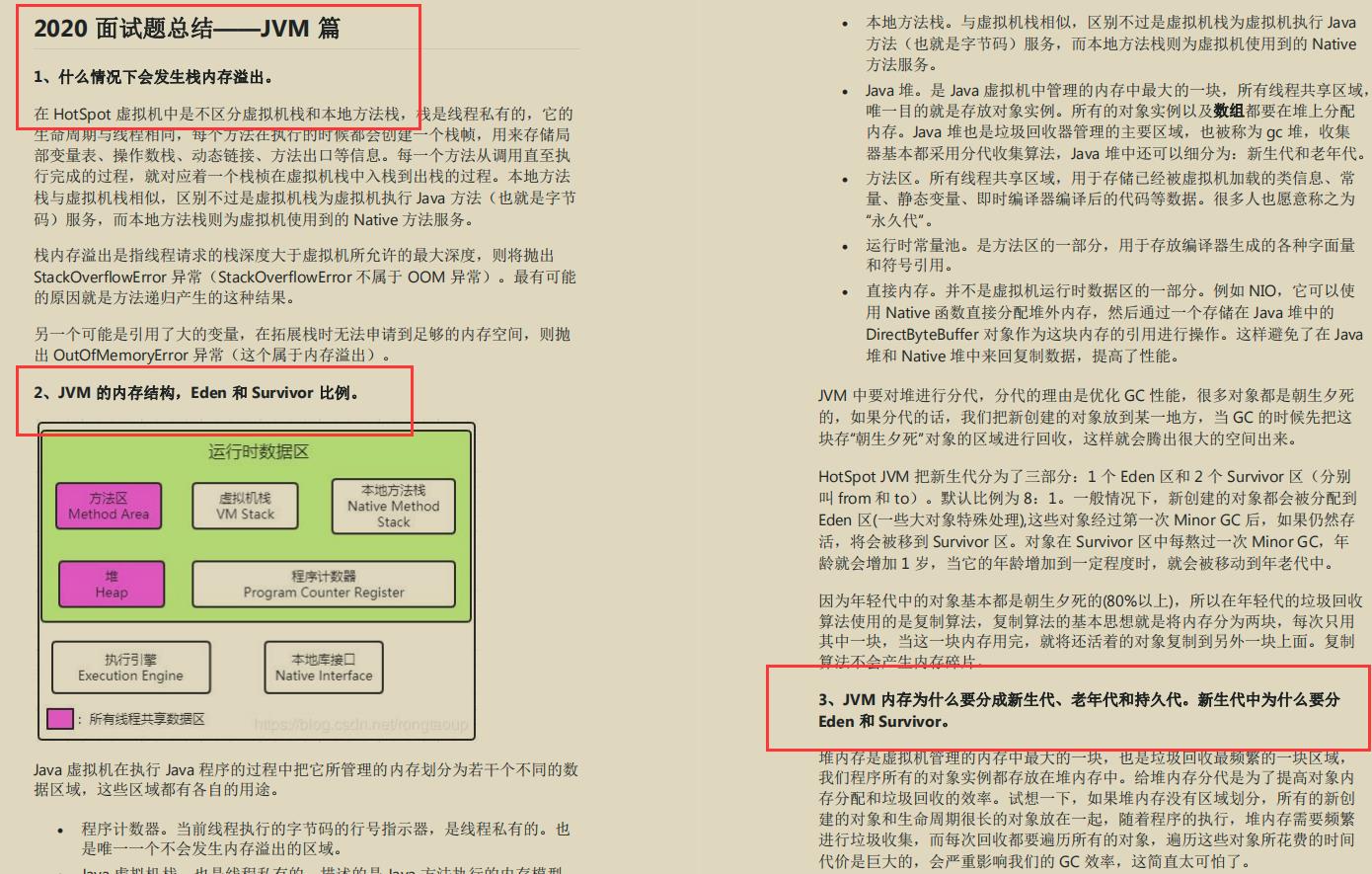
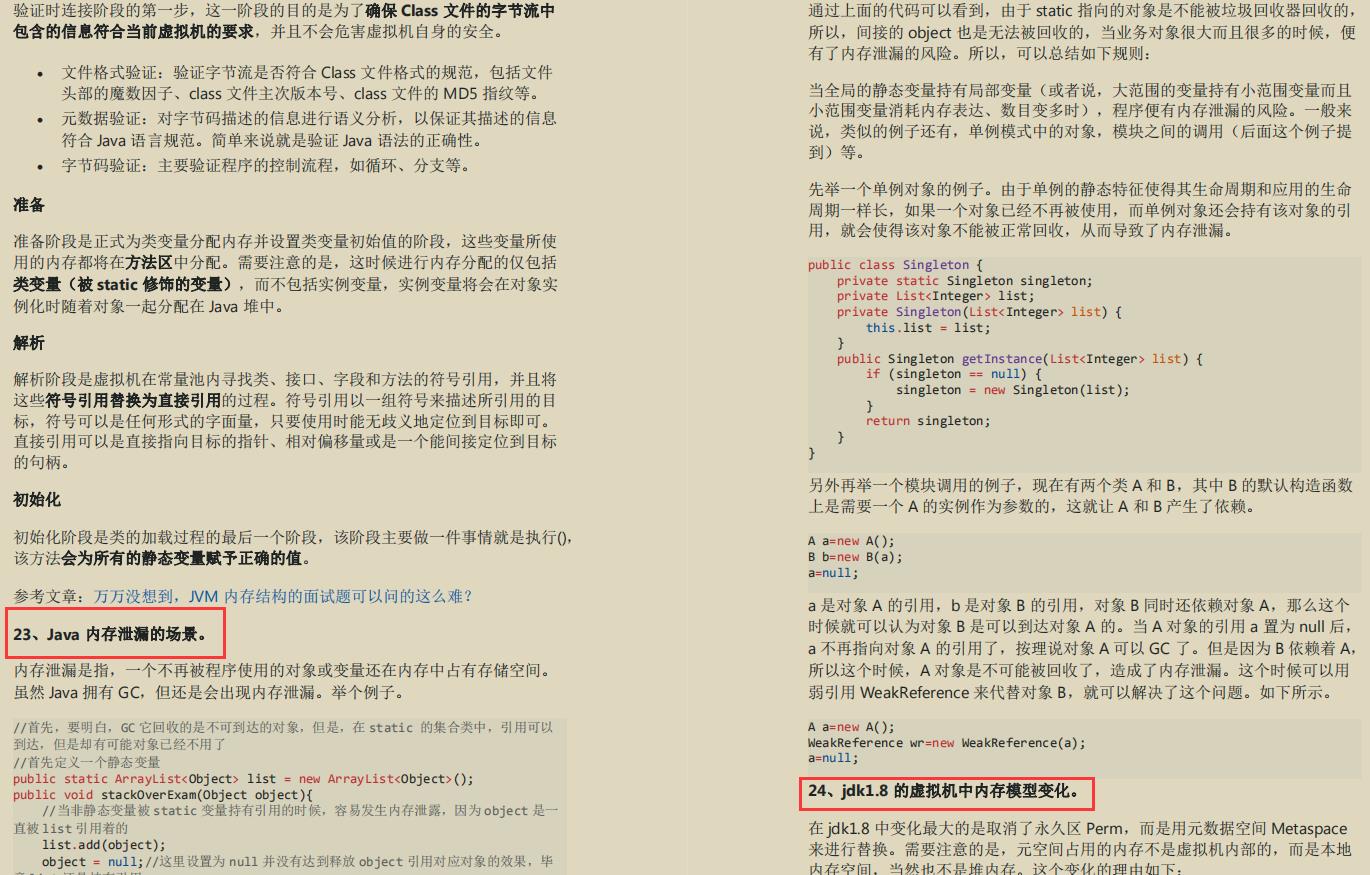
MySQL 篇
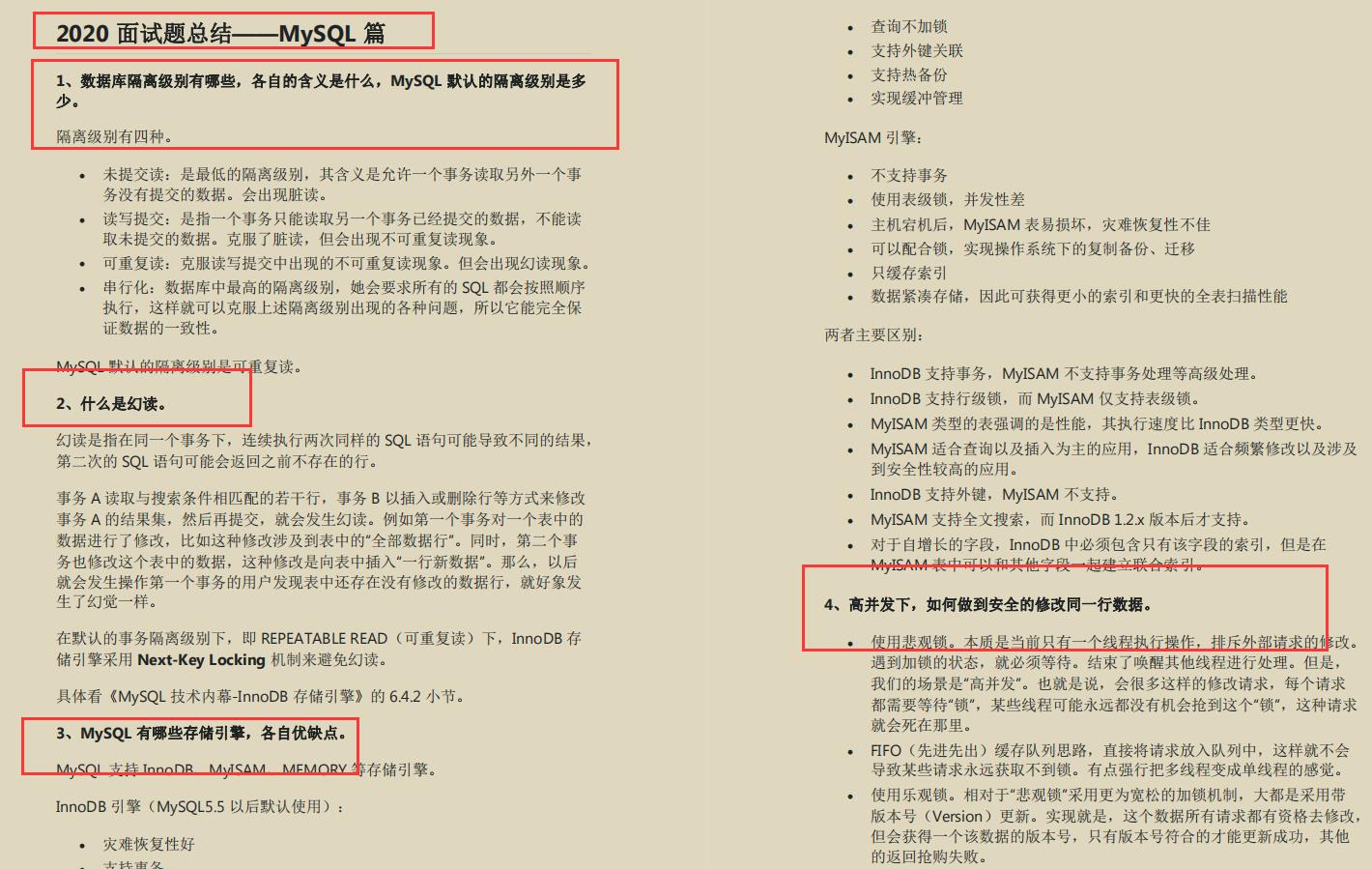
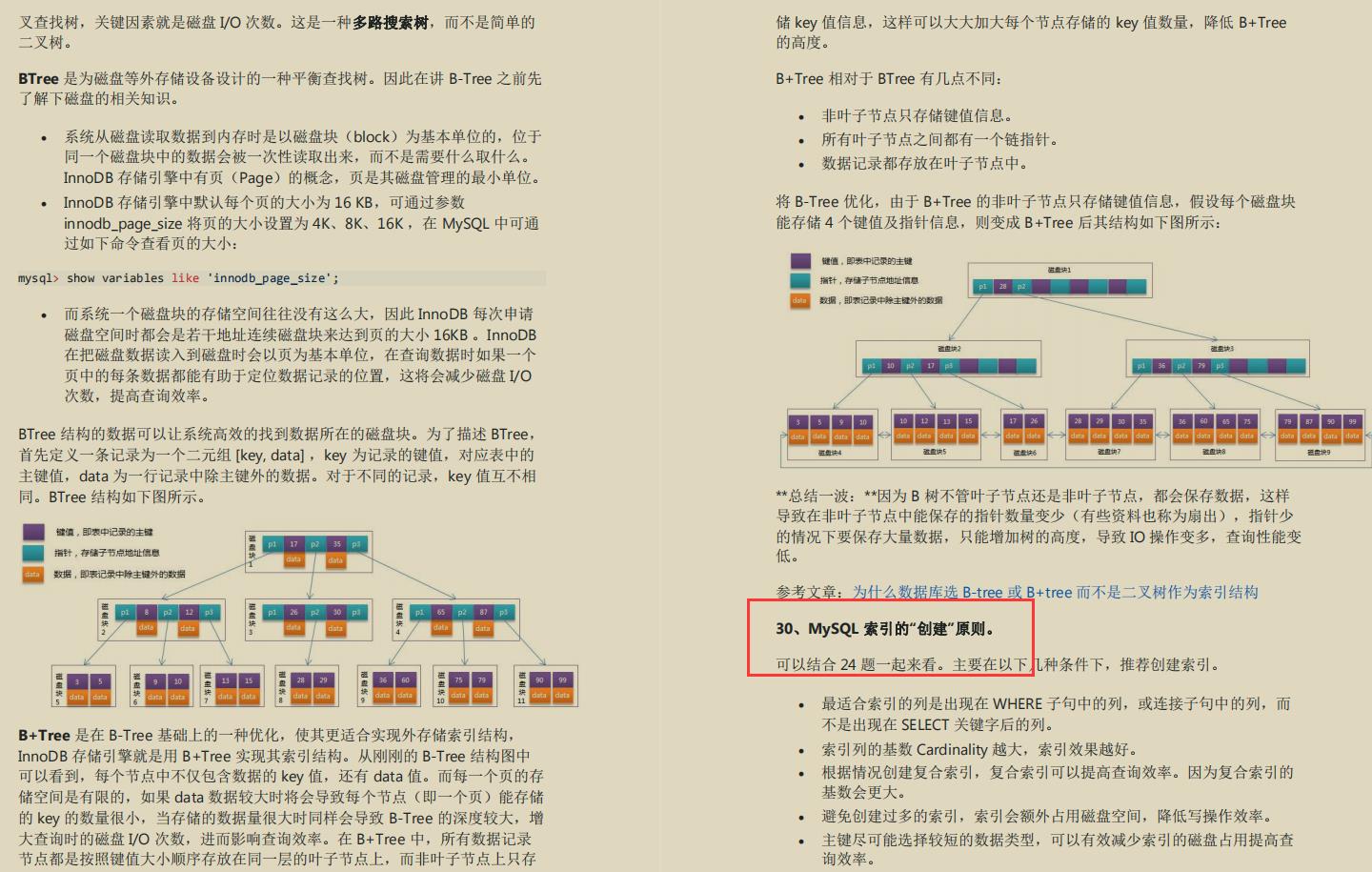
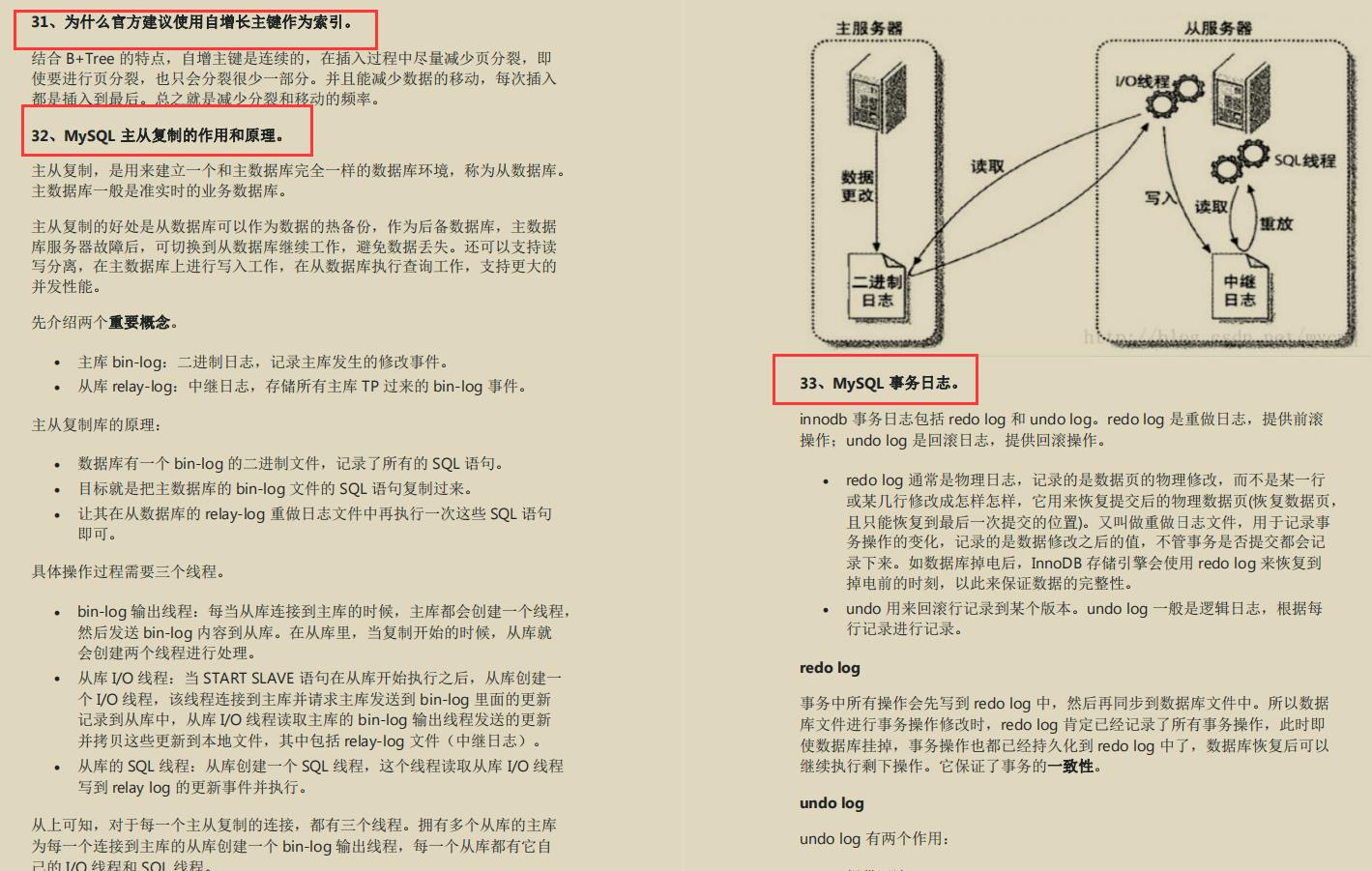
Redis 篇

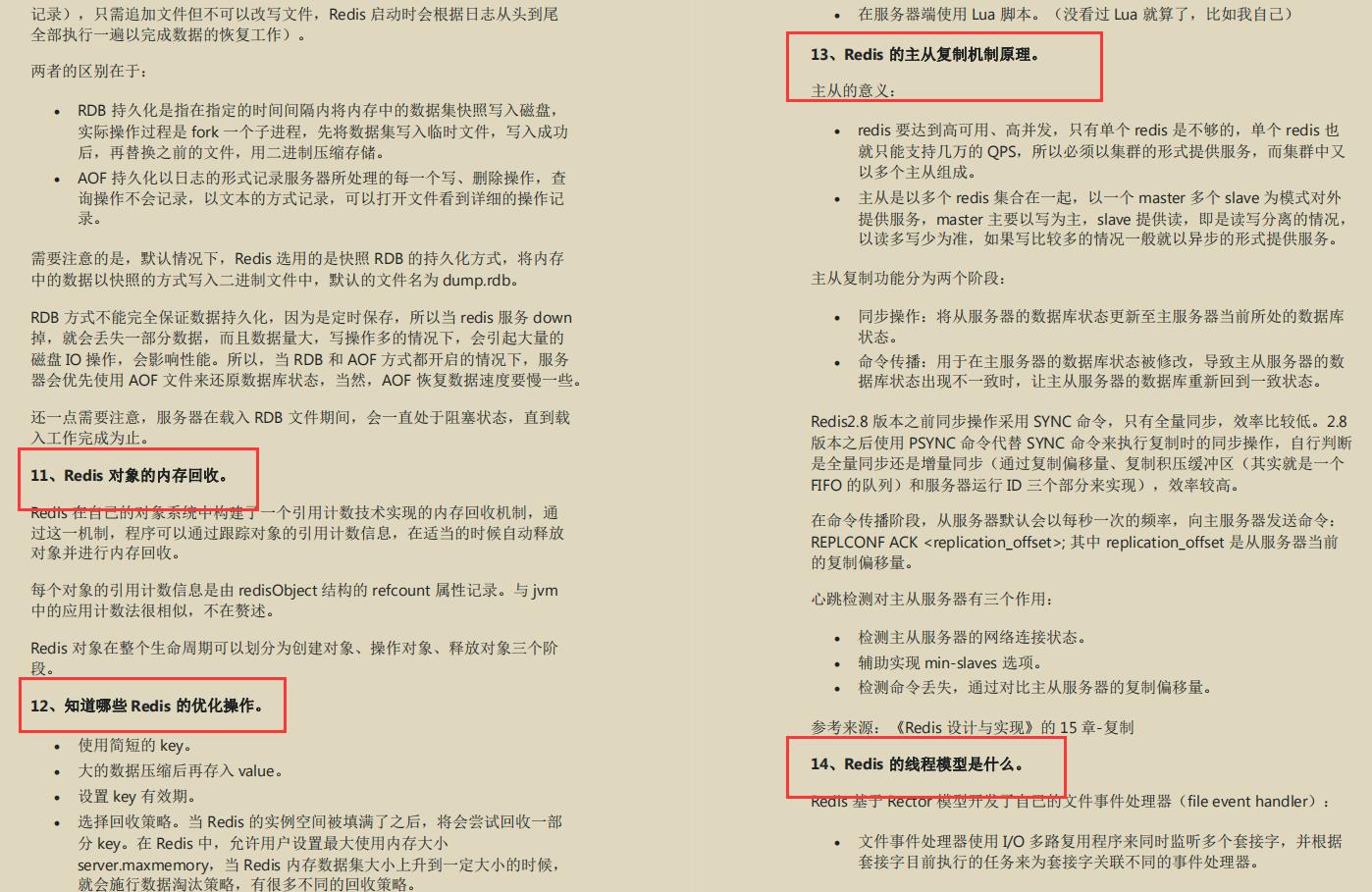


由于篇幅限制,详解资料太全面,细节内容太多,所以只把部分知识点截图出来粗略的介绍,每个小节点里面都有更细化的内容!
需要的小伙伴,可以一键三连,下方获取免费领取方式!
以上是关于spring中那些让你爱不释手的代码技巧(spring的故事续集)的主要内容,如果未能解决你的问题,请参考以下文章
